 username@email.com
username@email.com
In this lesson, you will review the Big Bang Theory; the life history of galaxies, solar systems, stars, and Earth; and rocks and radiometric dating.
Where did the Universe come from?
Significant evidence exists to support the theory that the Universe was created in a “big bang” event. The generally accepted and most common scientific theory that explains the origin of our Universe is that there was a big bang about 14 billion years ago — the Big Bang Theory.
Some form of an explosion took place at the moment the Universe began — starting from something about the size of a grain of sand and ending up as the Universe as we now know it.
Scientists agree that the Universe is currently expanding and thinning out. We know from the law of the conservation of mass, the total mass of the Universe is constant, so all the matter of the Universe must have been closer together at one time. This suggests that some original explosion may have started the galaxies moving away from each other.
From any place in the expansion, all other places appear to be moving away from each other at speeds proportional to their distances from the place of observation. The Big Bang Theory also implies that the Universe has a finite age, equal to the time since the big bang explosion.
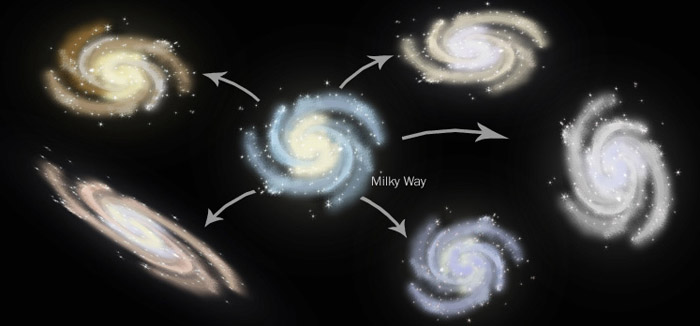
All galaxies appear to be moving away from the Milky Way galaxy. All particles appear to be moving away from each other as the Universe continues to expand.
Astronomers can measure how fast the Universe is expanding and the approximate distance to the furthest stars from parallax measurements. From this, they can calculate roughly how long the Universe has been expanding to assess its age. Based on measurements of how fast distant galaxies are moving away from us and on measurements of the cosmic background radiation, astronomers estimate that the Universe is about 13.7 billion years old.
Edwin Hubble, an American astronomer, made an important discovery in the 1920s that also helped give more credence to the Big Bang Theory. Hubble studied the spectra of many galaxies moving away from each other and found a way to determine how fast and in what direction our galaxy was moving relative to other galaxies. He discovered that with very few exceptions, all galaxies were moving away from each other simultaneously.
Hubble noticed an important relationship between the speed of a galaxy and how far it was away from us. He used the Doppler shifts in the galaxies’ light to arrive at this relationship known as Hubble’s Law: The faster a galaxy is moving away from us, the farther away it is from us. Hubble’s observations provide credibility to the Big Bang Theory.
If the Big Bang Theory is accurate, we would expect to find evidence that the Universe is still spreading apart today just as it began doing billions of years ago. All observations from telescopes have been unable to refute this central tenet of cosmology and astronomy. We might also expect evidence of excess energy remaining after the massive explosion. This, too, has been observed in every case where data are sufficient to make such a test.
What will happen to the Universe in the distant future? One possibility is that the Universe will continue to expand, as it is doing now, with its stars eventually using up all of their fuel and burning out like old light bulbs, making the Universe a cold and dark place. Another possibility is that the Universe will eventually stop expanding and start to implode. This would pull all the galaxies back together into a very dense black hole (like a recoiling rubber band) to result in a reverse of the big bang.
What does Hubble’s Law state?
The correct answer is C. The faster a galaxy is moving away from us, the farther away it is from us. Although some of the other examples may be true, none are the definition of Hubble’s Law.
The Universe contains an enormous number of galactic clusters, each full of billions of galaxies consisting of stars, solar systems, planets, errant dust, rocks, and gas clouds held together by their own gravity. There are billions of galaxies in the Universe with the largest galaxies containing as many as one trillion stars. It is hard to comprehend just how massive the Universe really is.
There are several different configurations that galaxies can have. The most common are spiral, elliptical, and irregular.
Spiral galaxies are shaped like a flat disc or pinwheel with a bulge in their center, and arms that spiral outward. The Milky Way galaxy is an example. Many bright, young stars, dust, rocks and gas make up the spiral arms. The youngest stars are found at the tips of the spiral arms. Very few new stars form in the denser central bulge. Many spiral galaxies have a barrel-shaped region of stars, and gas that passes through the center of the galaxy, perpendicular to the main axis. These galaxies are called barred-spiral galaxies.
Elliptical galaxies are galaxies without spiral arms and with more of a round or egg-shape to their center region. Although billions of stars are contained in elliptical galaxies, there is much less gas and dust between the individual stars. Because there is relatively little dust and gas (the stuff stars form from), there are fewer young stars in an elliptical galaxy than a spiral galaxy.
Irregular galaxies are galaxies that have no regular spiral or elliptical shape. Irregular galaxies are typically much smaller than spiral or elliptical galaxies and have much more dust and gases, so they have a much higher concentration of bright, young stars. They do not necessarily have cohesion as a unit.
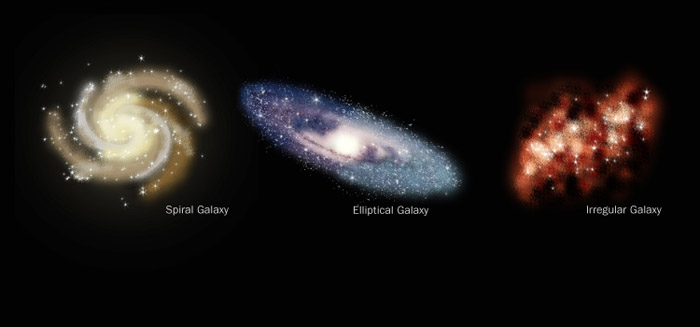
Major types of galaxies: Spiral, Elliptical, and Irregular.
There are also bright but very distant objects (10 billion years old or more) that look much like stars. “Quasi” means “something like” in Latin and hence, these objects were named quasi-stellar objects, which became quasars.
Further study has revealed that quasars are very young, active galaxies with giant black holes and large amounts of gas around the center. As the gas heats up from the extreme friction in the dense gravity, the quasar heats up and shines brightly.
What is the configuration of an elliptical galaxy?
The correct answer is A. Elliptical galaxies are without spiral arms and have a rounded center region. The other answers define configurations of other types of galaxies.
Our solar system is located in one of the arms of a spiral galaxy about half way from the center of the galaxy to the outer edge. Some evidence now exists that our galaxy may actually be a barred-spiral galaxy. However, the shape of the Milky Way galaxy depends on where it is viewed from. If you could view it from its side, it would look like a thin disk with a large bulge in its center. If viewed from the top or bottom you would see a typical spiral shape. The spiral shape cannot be seen from Earth because our solar-system’s vantage point is inside one of the galaxy’s spiral arms.
When we observe the Milky Way, we usually are looking toward the center of the galaxy, about 25,000 light-years away. We know its shape because we can study the center with X-rays, infrared radiation, and radio waves that are not blocked by the dust and gas, which does block visible light.

Our Galaxy, the Milky Way and our approximate location within it.
Stars do not last forever; they are born, have a relatively long life, and then transform into another kind of energy. All stars and galaxies initially form from a nebula—a large volume of gas and dust. When enough gas and dust contract due to gravity, a star can begin to form. At this early stage of development, when the contracting clouds of dust and gas contain enough mass to eventually form a star, the fledgling star is known as a protostar.
A star is “born” when the density of the contracting gas and dust causes intense heat and pressure, enough to start a nuclear fusion reaction. Recall that nuclear fusion occurs when individual atoms combine to form heavier atoms and, in the process, release tremendous amounts of energy. In most stars, hydrogen atoms combine with other hydrogen atoms to become helium atoms. The composition of most stars is about 73% hydrogen, 25% helium, and 2% of other elements with atomic numbers up to, but not exceeding, iron.
The lifetime of a star depends on its mass. Although you would assume that a star with a large mass would have a longer lifetime than a star with a smaller mass, the opposite is true. Stars with smaller masses have longer lifetimes than more massive stars. Why is this true? Even though small stars have less mass (fuel) to use, they use it more slowly than larger stars and therefore have much longer life spans.
Stars go through a life cycle, eventually dissolving or transforming into another type of celestial body. When a star has consumed nearly all of its fuel, its outer gases expand as the central core shrinks. At the time of “death” (when a star runs out of fuel to burn), the original mass of the star will determine if it becomes a red giant or a supergiant. Both of these transformed stars can evolve in different ways and become black holes, neutron stars, or black dwarfs.
Stars of low to medium mass, such as our sun, require billions of years to consume all their fuel. As they start to use up all the fuel, their outer layers expand and they become red giants. Eventually, red giants become white dwarfs as their outer regions grow larger and drift further out into space, forming a glowing cloud of gas called a planetary nebula. The core of the star that is left behind has a bluish-white color and cools to become a white dwarf.
White dwarfs are relatively small (about the size of the Earth) but they are very dense, having similar mass as our sun, but with a small volume. This gives white dwarfs a density about one million times the density of the sun. A handful of this material would have as much mass as a 20-story building on Earth. Having no fuel, white dwarfs glow faintly from leftover energy and, after billions of years, eventually fade and become black dwarfs.
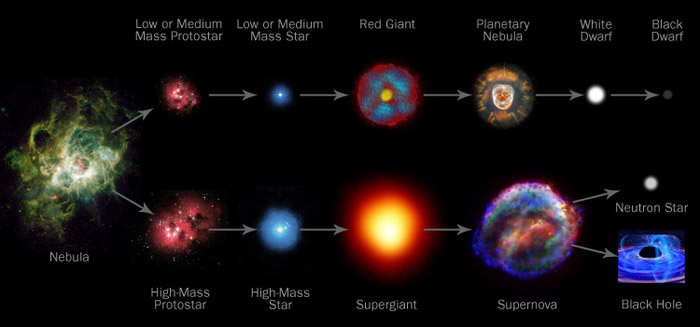
Life history of stars and other celestial bodies depends on their original mass.
Unlike the life cycle of a low- to medium-sized star, the life cycle of a more massive star ends quickly in a brilliant supergiant. When supergiants consume all their fuel, they suddenly explode, becoming much larger and millions of times brighter. This can happen in a matter of a few hours and the explosion is called a supernova. After the supernova, much of the star’s original material expands into space, probably to become part of another nebula or protostar.
When a supergiant explodes, some of the material left behind may form a neutron star. A neutron star is the remains of a star that once was very massive. They are even smaller and denser than white dwarfs, and while they can contain up to three times the mass of our sun, they can have a diameter as small as 24 km—the size of a typical city. These are truly massive and dense objects. Stars of sufficient mass may produce materials too massive to be classified as neutron stars. This massive remaining material may contract even further by its own gravity to create a black hole. The gravitational attraction in a black hole is so great that not even light is able to escape, therefore the area appears to be black.
Stars with a relatively small mass have what type of lifespan (compared to more massive stars)?
The correct answer is D. Small stars have long life spans. Larger stars live shorter and more intense lives, comparatively.
The sun, like all stars, does not have a solid surface but is a big ball of gas. Similar to Earth, however, it does have an interior and an atmosphere. The sun’s interior consists of the radiation zone, and the convection zone.
The sun’s core is where all the energy is produced. This energy is not generated by burning fuel but rather by the process of nuclear fusion, where hydrogen atoms combine to form heavier elements (usually helium) along with a tremendous release of energy. The mass of the helium produced is less than the mass of the hydrogen atoms consumed, and the difference is transformed and released as energy.
The energy produced in the sun’s core migrates to the radiation zone, the middle layer of the sun’s interior, and the region of dense gas where energy is transferred into electromagnetic radiation. The radiation zone is extremely dense and it can take more than 100,000 years for energy to move through it.
The convection zone is the outer layer of the sun’s interior where hot gases rise from the bottom of the convection zone and gradually cool as they reach the top of the convection zone, only to sink again, heat up again, and form loops of gas transport toward the sun’s surface.
The sun’s atmosphere consists of three layers: the photosphere, the chromosphere, and the corona. The photosphere is the innermost layer of the sun’s atmosphere and is considered to be the visible surface of the sun. It is made up of gases because the sun does not have a solid surface. The chromosphere is the thin middle layer of the sun’s atmosphere usually not visible due to the bright glare from the photosphere. The chromosphere is visible only during a total solar eclipse when the moon blocks the light from the photosphere. Then, the reddish glow of the chromosphere just above the photosphere is visible. The corona is the outermost layer of the sun’s atmosphere which extends about one and a half million km into space from the sun’s surface.
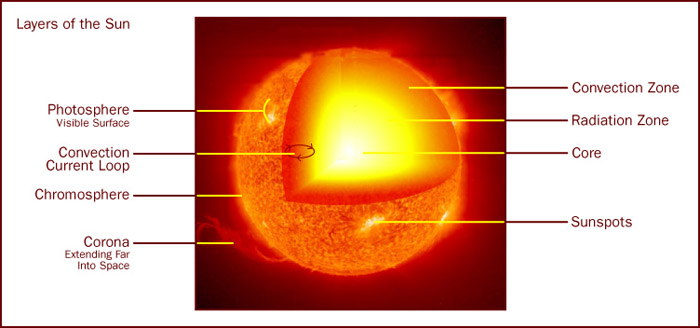
What is the sun’s photosphere?
The correct answer is A. Choices B, C, and D define other parts of the Sun.
The Earth is divided into four main components or spheres: the lithosphere, the hydrosphere, the atmosphere, and the biosphere. Any change in one sphere causes changes in one or more of the other spheres. Matter and energy constantly move from one sphere to another. For example, the water system moves water and energy in a cycle that may involve an interaction between the oceans, the atmosphere, and the land. The sun supplies almost all of the energy for Earth’s processes, both biotic and abiotic. For example, the sun supplies the energy to keep the water cycle in constant motion. The sun’s energy is transferred to the Earth as radiation, a form of energy that can travel through empty space. The suns’ radiation warms the surface of the Earth. Much of the remainder of the energy transferred in Earth’s systems comes from the heat of Earth’s interior, finding its way to the surface primarily through volcanic eruptions.
All systems of the Earth are interlinked and interdependent. Earth’s solid rocky layer is called the lithosphere. Earth’s water bodies (rivers, oceans, lakes, and ice) form the hydrosphere; the oceans affect the temperature of the atmosphere; and flowing rivers shape the topography of the lithosphere. All habitats for living organisms on Earth, whether in air, on land, in water, or underground, form the biosphere. Plant growth constantly changes the surface of the lithosphere and gases expelled by plants affect the atmosphere. Storms in the atmosphere bring rains that change the surface of the lithosphere. The atmosphere, Earth’s outermost sphere, consists of a mixture of gases that surrounds the planet. All spheres are tightly interrelated and constantly affect each other.
The three main layers of the Earth are its crust, mantle, and asthenosphere, which is hotter and under higher pressure than the lithosphere and therefore is a little less solid than the rock above. Visualize plates of the lithosphere ‘floating’ on a very dense fluid-like asthenosphere. Below the asthenosphere is Earth’s core.
The core is a very dense concentration of mostly iron and some nickel. It consists of two parts: a solid inner core and a liquid outer core. These two layers are 35,000 km thick. The outer layer of the core is molten metal and it surrounds the inner core which is a dense sphere of solid metal. Extreme pressure within the inner core compresses atoms of iron and nickel so much that they cannot form a liquid. Although both layers are primarily made of iron and nickel, scientists are now determining that oxygen, sulfur, and silicon are also present.

Surrounding the Earth’s surface is an envelope of gases called the atmosphere. Earth’s atmosphere is made up mostly of a mixture of atoms of nitrogen and oxygen, as well as some particles of liquid and solids. The most abundant gas in the atmosphere is nitrogen, which accounts for approximately 78% of the air we breathe. The next most abundant gas in the atmosphere is oxygen, which accounts for 21% of our air. The remaining 1% of the atmosphere is made up of (in decreasing order) argon, carbon dioxide, neon, helium, methane, krypton, and hydrogen. The atmosphere is relatively thin, only extending a few hundred kilometers from Earth’s surface.
The atmosphere supports the conditions for life on Earth, making the Earth suitable for living things. Just like all the other spheres, the atmosphere is constantly changing with gases being exchanged between and among the different Earth systems. The atmosphere also traps water and heat near the surface of the Earth. The heat held near the Earth makes it possible for water to exist as a liquid and provides the temperature ranges suitable for life as we know it. The atmosphere promotes a stable environment by preventing excessive solar radiation from reaching the Earth and protects the Earth’s surface from most meteor impacts.
Just like the layers of the Earth, the atmosphere is comprised of a series of four main layers of different temperatures: the troposphere, the stratosphere, the mesosphere, and the thermosphere. The thermosphere is further divided into the ionosphere and the exosphere.
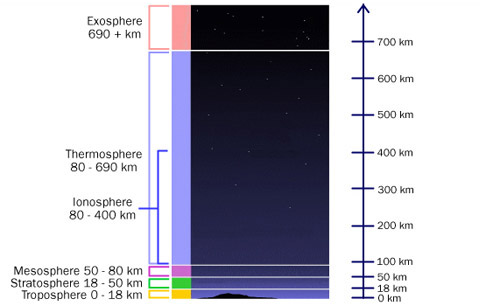
In sequence from the ground up, the first layer is the troposphere. We live in this layer and it is where all weather occurs. The troposphere extends from ground level up to about 12 km above the surface of the Earth. While the troposphere is the thinnest layer of the atmosphere, it contains almost all of the mass of the atmosphere because heavier atoms congregate closer to the Earth under the influence of gravity. The temperature is the highest at the bottom of the troposphere and decreases about 7° C for every kilometer of altitude. At the top of the troposphere, the temperature levels out at about -60° C. The temperature drops at a constant rate as altitude increases. The troposphere is the component of the atmosphere where weather conditions exist.
The stratosphere is the next layer above the troposphere and extends upward about 50 km. It contains the ozone layer and is the layer that absorbs most ultraviolet radiation. The lower regions of the stratosphere are the same temperature as the top of the troposphere. Surprisingly, there is a layer where, as you go higher up, it starts to get warmer. When ozone absorbs energy from the sun, heat is generated and warms the surrounding air. Unlike the troposphere, the temperature in the stratosphere increases at a constant rate as altitude increases.
The mesosphere is the third layer of the Earth’s atmosphere. It is the layer that protects the Earth’s surface from being struck by most meteoroids. When you see a shooting star, you are seeing a trail of hot gases glowing in the mesosphere. The mesosphere is marked by a reversal of temperatures, getting colder as altitude increases. In the outer mesosphere, temperatures drop to -90° C.
The thermosphere is the fourth and outermost layer of Earth’s atmosphere. The thermosphere extends from 80 km above Earth’s surface upward, gradually blending into outer space. The air in the thermosphere is very thin and hot, because there has been a reversal of temperatures in these layers. The air in the thermosphere can reach 1,800° C because this is the first layer to be struck by sunlight, and nitrogen and oxygen molecules convert this energy into heat.
The thermosphere is divided into two layers: the ionosphere and the exosphere. The ionosphere goes from about 80 km to 400 km above the Earth. The molecules in the ionosphere become ions, electrically charged by the sun’s radiation. Ions are efficient at reflecting radio waves and are responsible for the propagation of radio waves back to Earth. The aurora borealis also occurs in the ionosphere. The outer layer of the atmosphere, the exosphere, extends from about 400 km above Earth’s surface outward thousands of km, essentially blending into outer space. Cellular phone calls and television pictures are relayed by communication satellites that orbit in the exosphere.
Scientists currently believe that movement in the liquid outer core of Earth is responsible for the Earth’s magnetic field. A compass points northward because the Earth acts as a huge magnet. The compass needle aligns itself with the magnetic field of the Earth, slightly off of true geographical north in most cases. The northern magnetic pole of the Earth is located about 1,770 km away from the true North Pole, somewhere in the Hudson Bay region of northern Canada. The southern magnetic pole is located south of Australia. The difference between where a compass points and the true geographical pole is known as magnetic declination.
It is not known exactly why the Earth has a magnetic field of such strength. The configuration of the Earth’s magnetic field is like that of a strong bar magnet placed near the center of the Earth. But the Earth is not a magnetized piece of iron like the bar magnet we are all familiar with. The liquid part of Earth’s core is simply too hot for the individual atoms to remain aligned in a magnetic conformation. So, why is the Earth basically a magnet? Scientists currently believe that movements in the liquid core cause charged particles to move (a moving charge creates a magnetic field), looping within the Earth to create its magnetic field. The convection currents of the core may also be affected by the rotation of the Earth, and this may add to the Earth’s magnetic field.
The Earth’s surface is covered by more than 70% water. Earth differs from all other known planets because of water, which is largely responsible for life on Earth. Water on Earth today (like energy and mass) is the same that was here many years ago; it is recycled over and over in the water cycle.
The water cycle is a continuous process during which water moves from the atmosphere to various bodies of water, to land and living things, and back to the atmosphere, completing the cycle. The water cycle has three main components—evaporation, condensation, and precipitation—and is primarily driven by the sun’s energy.
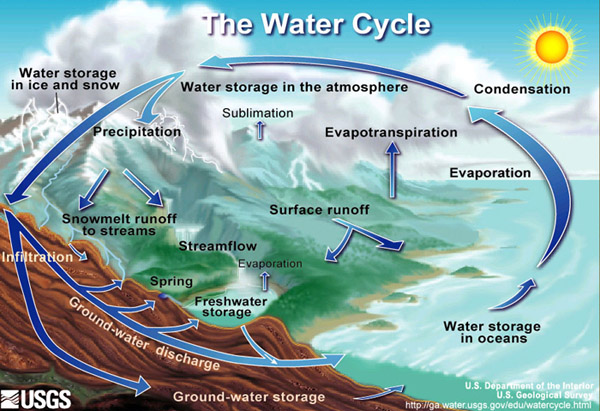
During evaporation, water is transformed from a liquid (in oceans, lakes, rivers, and soil) to a gas, water vapor. Plants aid in evaporation by drawing water from their roots and releasing it through their leaves as water vapor (a process called evapotranspiration).
Condensation is the transformation of water vapor back to liquid form by any of a series of ambient changes (temperature, pressure, etc.) that help it change state. For example, water vapor is often carried upward on thermal currents, and cools dramatically at higher altitudes, condensing into liquid water. Molecules of condensed water collect together on tiny dust particles in the air to form clouds. As more and more water vapor condenses, the drops of water in the clouds become larger and then too large to stay in the cloud. Eventually the larger drops fall back to Earth as precipitation in the form of rain, snow, sleet, or hail.
The precipitation falls all over Earth—some directly back to the oceans or lakes— but the water that falls on land may soak into the ground or simply run off the surface and find its way back into rivers, lakes, and oceans where the process starts all over again.
What source of energy keeps the Earth’s water cycle running?
The correct answer is B. Nearly all processes on Earth have the Sun’s energy as their primary source.
A key process on the Earth’s surface is rock formation. First off, let’s get reacquainted with rock types. Rocks are classified according to their origin and composition. There are three main types of rock: igneous, sedimentary, and metamorphic.
Igneous rock forms during the cooling process of Earth’s magma or lava. It may form on or beneath the surface from lava eruptions. Igneous rock that forms from lava on the Earth’s surface is called extrusive rock, the most common of which is basalt. Basalt is also the most common rock on Earth and forms much of the oceans floor. Igneous rock that forms when magma hardens beneath the Earth’s surface is called intrusive rock. The most abundant intrusive rock on Earth is granite, which helps to form many mountain ranges.
Sedimentary rock forms when particles of other rock, or plant or animal remains are pressed together for long periods. Most sedimentary rocks are formed by erosion, deposition, compaction, and cementation. Sedimentary rocks are easily identified because they usually have layers of different sediments that are readily apparent. Many fossils are found in sedimentary rock.
Metamorphic rock forms when existing rock is altered by pressure or heat under the surface of the Earth. Sometimes forces deep within the Earth push rock down toward the mantle where pockets of magma rising through the crust provide additional heat that can produce metamorphic rock. The deeper underground, the more pressure there is on the rock. Under high temperature and pressure, the minerals in one kind of rock can be changed into other minerals forming metamorphic rock.
While most atoms are stable and do not change over time, some are unstable and break down over time, releasing particles and energy in a process called radioactive decay. Radioactive decay is the process in which atoms of one element break down to form another element. This decay takes place naturally in most igneous rock and can be used by scientists to determine the age of the rock.
As radioactive elements in the rock decay over long periods of time, they change the composition of the rock. The rate of decay of any radioactive element is constant, and is referred to as the element’s half-life. When one-half of its original mass has decayed to a lower energy state, that period of time is called the element’s half-life. To effectively date a substance, scientists simply compare the ratio of the unchanged versus the changed forms of the element. The most prevalent radioactive element with a half-life appropriate to determine the age of most rocks is carbon-14 (written in scientific notation: 14C, a relatively unstable isotope) and its ratio to carbon-12 (12C, a more stable isotope of carbon).
Carbon-14 dating is most useful in dating materials from plants and animals that are less than 50,000 years old. This is because carbon-14 has a half-life of 5,730 years. After every 5,730 years, the amount of carbon-14 remaining in a rock or fossil is cut in half. For this reason, it cannot be used to accurately date ancient fossils because, after approximately 10 half-lives (50,000 years), the amount of remaining carbon-14 becomes too small to measure accurately. For much older dating, materials with longer half-lives (such as potassium-40 with a half-life of 1.3 billion years) are used to accurately measure the age.
Why is carbon-14 radioactive dating not appropriate for determining the age of materials approximately one billion years old?
The correct answer is C. All carbon on Earth exists as a ratio of different isotopes, carbon-14 being one of the easiest to measure because of its relative ratio in most carbon-bearing substances (due to its half-life).